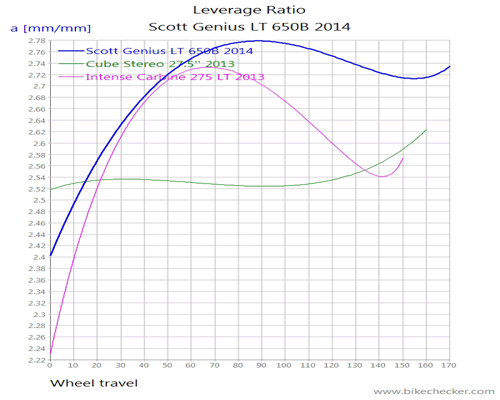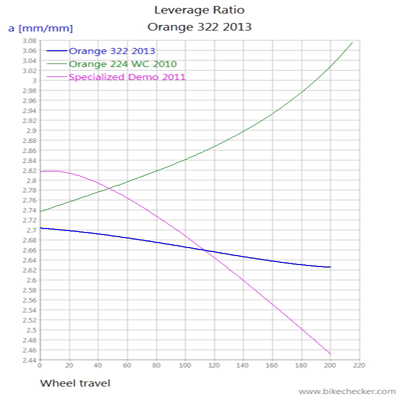MegaSack DRAW - This year's winner is user - rgwb
We will be in touch
i'm sure the linear rate of coil suspension used to be desireable.
i certainly think so.
is it that air curves have become more linear due to improvements in compression damping, so there's relatively more support in the mid-stroke, so can be run slightly lower pressure, so need a ramp up at the end to prevent bottom out? that's the only logic i can work out.
but the way it's toted, it's made to sound like it's inately a good thing.
eg here from the Bird site:
[i]Sleek lines, bob-free pedalling and progressive shock curve combines to make the hardest hitting yet pedal friendly 150mm travel bike around. [/i]
or are we going deeper and talking about the relationship between frame leverage curve (what's the term for that again?) and resultant possible shock tunes? doesn't sound like it. that's presumable a bit involved to be used in sales talk?
enlighten me
Motorbikes added progressive linkages in the 80s, so it's not exactly news.
We're all so gnarcore now, it's good for bottom out resistance. Innit.
All the linear coils I had then had extra to make them ramp up at the end...
so it's just about bottom out resistance?
but still, doesn't progressive imply wallowy midstroke? smirk
is the ideal to be fairly linear till the end of the stroke where it would ramp up?
probably over-simplifying i know
In the olden days air springs were far, far too progressive so a linear coil spring was a massive improvement but they still needed a bit of progression at the end to prevent a harsh bottom out. In modern times the air springs are greatly improved so it is now a thing to desire some progression. (I guess there is more air capacity relative to the travel?)
so air springs behave in a more linear fashion now due to improvements in compression damping eg bladder cartridges?
My current bike (Kona Process) has a consistent progressive suspension curve.
I love how it feels totally supportive and predictable. It's very confidence inspiring and it means I can go faster.
I'm very far from an expert on these things, but I suspect the much-improved performance of rear shocks has helped make simpler suspension platforms competitive with the more complicated ones.
chaka, isn't that an oxymoron. isn't consistenly rate of change means linear. progressive means not consistent. that'a how i understnd it.
i take your point tho
chaka, isn't that an oxymoron. isn't consistenly rate of change means linear. progressive means not consistent. that'a how i understnd it.
I took it to mean that the rate of progression is consistent, if that makes sense?
Bike suspension setups have never been linear. Linkages or shock locations where coil sprung have given a ramp up at the end for a long time (on anything sensible) and every coil sprung fork I'm aware of except some late 90s Pace forks has an air volume in the fork leg that will give a progressive spring rate even with a linear spring.
I think the problem with early air suspension setups was that they were perhaps a bit too progressive/arbitrarily progressive rather than set up carefully to give a nice feel to the suspension. Well it wasn't the only problem, but...
the curve of the curve doesn't change i guess you mean chaka, yes
the curve of the curve doesn't change i guess you mean chaka, yes
Yep, I've always been crap at describing how suspension feels - but there are no unexpected trapdoor sensations while riding, which makes for more confidence to commit to technical bits or corners.
well my effort wasn't that great!
but i've still not [i]really[/i] had my questions answered...
Welcome to STW. You pose a question and forumites will spend 5 pages arguing over what it means.
Progressive suspension is great as in the early part of the stroke, there is less stiction, thus more small bump sensitivity, then as the shock get deeper into its travel, there is more support.
Air shocks naturally exhibit progression and it can be tuned by altering the spring volume, either with volume spacers, or at the extremes, different air cans.
However, when a bike manufacturer is talking about progression, they'll be refering to the leverage curve of the design, which the shock they supply will be tuned to compliment.
Say you start with a leverage ratio of 3.5, to make the suspension especially sensitive on small features, then over the curve, the leverage ratio goes down to 2.1~ although the number has decreased, the overall effect is ramping up, as there is less leverage working on the shock, reducing the force and effectively deccelerating the shock through it's travel and preventing harsh bottom out
This is near as dammit the perfect leverage ratio curve:
This is pants (albeit not that pants in the real world, as there isn't that much deviation):
And this is less pants and more linear, albeit with a bit of progression:
Linear suspension is wack yo
Progression, in this sense, refers to an increasing of stiffness as you go through the stroke. The thinking being that it stops a harsh bottom our gradually increasing stiffness at the end of the stroke.
The real rate is a function of both suspension design and shock stiffness behaviour. Personally I believe a linear frame ratio, with a progressive air shock is the best answer. Simple, and easy to adjust the shock to get the behaviour you want.
Linear suspension is good for suspension tuners. It makes it easy for them to work out what shims to use. High speed compression damping can then be used to control bottom out to an extent.
But it is mostly marketing. Why did we all want large volume air cans a few years back for more progressive rates. But now were all sticking reducing rings in our shocks!
Plus it all going to be redundant soon when the Oleo strut shock takes off. I'm getting a Nitro Shox prototype for my Starling Swoop soon. If it delivers what it promises, it is has auto adjusting damping!
I liked my Herb, it went linear to progressive and had a linkage path that hurt my eyes. Felt like it had a flat tyre, all the time, but it went like stink.
progression is good until you ride it then you put loads of bottomless tokens in to 'firm up the midstroke' and tune all that progression out.
its all aimed at providing ammunition for trailside/carpark chat really.
Its getting progressively more complicated. Next we will be adding shampoo-scientific terms to sell more boing.
It isn't just about the spring, it's about the damping too. You can reduce the volume of an air spring to make it ramp up more and with some shocks you can increase the high speed compression damping to resist hard bottoming - but with a progressive leverage ratio a linear air can will naturally ramp up and the damping will increase as you dive further into the travel.
Continuing the graphs, this (blue) is rubbish:
Whilst the Orange 322 is so much better than the 224 in this respect:
The Banshee Spitfire is great for a 140mm bike:
Whilst as the Rune is a 160mm frame it isn't so progressive to reduce the chance of midstroke wallow:
progression is good until you ride it then you put loads of bottomless tokens in to 'firm up the midstroke' and tune all that progression out.
Except adding bottomless tokens softens the midstroke! 😉
i'm sure the linear rate of coil suspension used to be desireable.
What JHJ said.
You want it linear at first, and in the middle, and ramp up at the end. My coil 66s (which were amazing, hope whoever you thieving scumbag sold them to is enjoying them) had a linear spring but had to avoid bottom out with a two stage damper that ramped up the damping for the last inch.
I'm getting a Nitro Shox prototype for my Starling Swoop soon
ooooh, very much want to hear what you think of that, would love to try one out but easier said than done!
DUH...progressive is a good thing because it has PRO at the beginning...
depending on what kind of ride you like regressive may be better,
a stable platform that will give way and soak up big stuff and naturally complement an air springs characteristics?
oh sorry thats next years marketing bullshit 😉
this is wrong:
The real rate is a function of both suspension design and shock stiffness behaviour. Personally I believe a linear frame ratio, with a progressive air shock is the best answer. Simple, and easy to adjust the shock to get the behaviour you want.
This is right:
It isn't just about the spring, it's about the damping too. You can reduce the volume of an air spring to make it ramp up more and with some shocks you can increase the high speed compression damping to resist hard bottoming - but with a progressive leverage ratio a linear air can will naturally ramp up and the damping will increase as you dive further into the travel.
A progressive spring will store up more energy in the last bit of the stroke, and resit bottoming out, but a progressive linkage will do the same to the spring rate and damping, so that the rate of damping is consistent with the energy stored in the shock. Without that you'd end up with a lot of energy stored up, and nowhere to dissipate it.
Where it get's complicated is with things like position sensitive damping (manitou TPC+), which act like a progressive spring, for the damper. Unlike speed sensitive damping which only deals with the shafts speed, not it's position (pretty much every other damper).
I'm getting a Nitro Shox prototype for my Starling Swoop soon
ooooh, very much want to hear what you think of that, would love to try one out but easier said than done!
Very curious about this too!
TBH, most of us with air suspension back in the day used to tune the spring curve with a few CCs of oil.
Most of the high end coil shocks over the past ten years or so have had some form of tuneable progression too, it used to be referred to as "Bottom-out resistance".
Most of the high end coil shocks over the past ten years or so have had some form of tuneable progression too, it used to be referred to as "Bottom-out resistance".
Do they use the nitrogen charge in the piggyback to do this?
you can adjust the air pressure or reduce the volume behind the IFP on many coil shocks and some air. the foam bumber is also tuneable.







